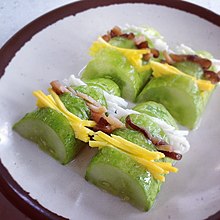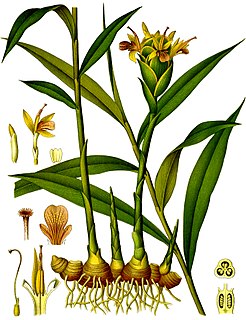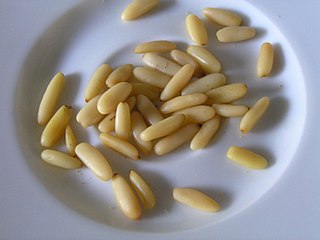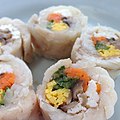
Moussaka is an eggplant- (aubergine) or potato-based dish, often including ground meat, in the Levant, Middle East, and Balkans, with many local and regional variations.
Romanian cuisine is a diverse blend of different dishes from several traditions with which it has come into contact, but it also maintains its own character. It has been mainly influenced by a series of European cuisines such as the Austrian cuisine, German cuisine, Greek cuisine, or Hungarian cuisine, yet it also includes culinary elements stemming from the cuisines of the Slavic-speaking countries of Eastern and Central Europe, most notably Serbian and Bulgarian as well as Polish, Ukrainian, and Russian.

Korean royal court cuisine was the style of cookery within Korean cuisine traditionally consumed at the court of the Joseon Dynasty, which ruled Korea from 1392 to 1910. There has been a revival of this cookery style in the 21st century. It is said that twelve dishes should be served along with rice and soup, with most dishes served in bangjja (bronzeware).

Pickling is the process of preserving or extending the lifespan of food by either anaerobic fermentation in brine or immersion in vinegar. The resulting food is called a pickle, or, to prevent ambiguity, prefaced with pickled. The pickling procedure will typically affect the food's texture and flavor. In East Asia, vinaigrette is also used as a pickling medium. Foods that are pickled include meats, fruits, eggs, and vegetables.

Banchan is a collective name for small side dishes served along with cooked rice in Korean cuisine. As the Korean language does not distinguish between singular and plural grammatically, the word is used for both one such dish or all of them combined. The basic table setting for a meal called bansang (반상) usually consists of bap, guk or tang (soup), gochujang or ganjang, jjigae, and kimchi. According to the number of banchan added, the table setting is called 3 cheop (삼첩), 5 cheop (오첩), 7 cheop (칠첩), 9 cheop (구첩), 12 cheop (십이첩) bansang, with the 12 cheop used in Korean royal cuisine.

Haejang-guk (해장국) or hangover soup refers to all kinds of guk or soup eaten as a hangover cure in Korean cuisine. It means "soup to chase a hangover" and is also called sulguk. It usually consists of dried Napa cabbage, vegetables and meat in a hearty beef broth. One type of haejangguk, Seonjiguk, includes sliced congealed ox blood and another type, Sundaeguk includes a kind of blood sausage made with intestine stuffed with pig's blood and other ingredients.

Muk or mook is a Korean food made from grains, beans, or nut starch such as buckwheat, sesame, and acorns and has a jelly-like consistency. Muk has little flavor on its own, so muk dishes are seasoned with soy sauce, sesame oil, chopped scallions, crumbled gim, and chili pepper powder, and mixed with various vegetables.

Confit byaldi is a variation on the traditional French dish ratatouille by French chef Michel Guérard.

Jeon refers to a dish made by seasoning whole, sliced, or minced fish, meat, vegetables, etc., and coating them with wheat flour and egg wash before frying them in oil. Jeon can be made with ingredients such as fish, meat, poultry, seafood, and vegetable, and be served as an appetizer, a banchan, or an anju. Some jeon are sweet desserts; one such variety is called hwajeon.
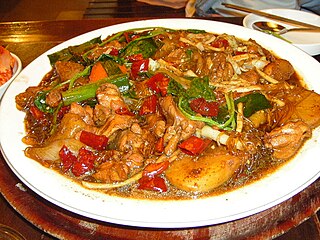
Jjim is a Korean cuisine term referring to dishes made by steaming or boiling meat, chicken, fish, or shellfish which have been marinated in a sauce or soup. The cooking technique originally referred to dishes cooked in a siru by steaming. However, the name jjim has now come to imply a finished dish with a steamed appearance. The cooking method for most jjim dishes nowadays has changed to boiling the ingredients in broth and reducing the liquid. Pressure cookers are popular for making jjim as well.

Andong-jjimdak (안동찜닭) is a variety of jjim, which originated in the city of Andong, Gyeongsangbuk-do Province and is made with chicken, various vegetables marinated in a ganjang based sauce. The name literally means "steamed chicken of Andong."

Gyeran-jjim (계란찜) or steamed eggs is a type of jjim, Korean steamed dish. It is a custardy, casserole-like banchan, often seasoned with saeu-jeot or myeongnan-jeot and topped with scallions and toasted sesame seeds. The ideal gyeran-jjim is light and fluffy.

Lalab or lalap is a Sundanese raw vegetable salad served with sambal terasi. It is a popular Sundanese vegetable dish originated from West Java, Indonesia.

Karedok is a raw vegetable salad in peanut sauce from West Java, Indonesia. It is one of the Sundanese signature dish. It originally included cucumbers, bean sprouts, cabbage, legumes, Thai basil, and small green eggplant, covered in peanut sauce dressing, but there are now many variations. It is very similar to gado-gado, except all the vegetables are raw, while most of gado-gado vegetables are boiled, and it uses kencur, Thai basil and eggplant. Karedok is also known as lotek atah for its fresh and raw version of the vegetable covered with peanut sauce. Karedok is widely served as daily food in the Sundanese family, usually eaten with hot rice, tofu, tempeh and krupuk. Nowadays karedok can be found in many variation from hawkers carts, stalls (warung) as well as in restaurants and hotels both in Indonesia and worldwide.

Gado-gado, also known as lotek, is an Indonesian salad of slightly boiled, blanched or steamed vegetables and hard-boiled eggs, boiled potato, fried tofu and tempeh, and lontong, served with a peanut sauce dressing. In 2018, gado-gado is promoted as one of 5 national dishes of Indonesia.







